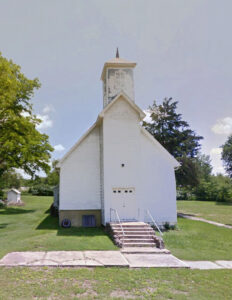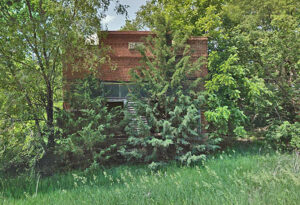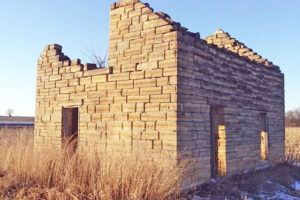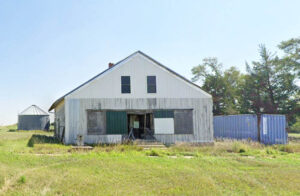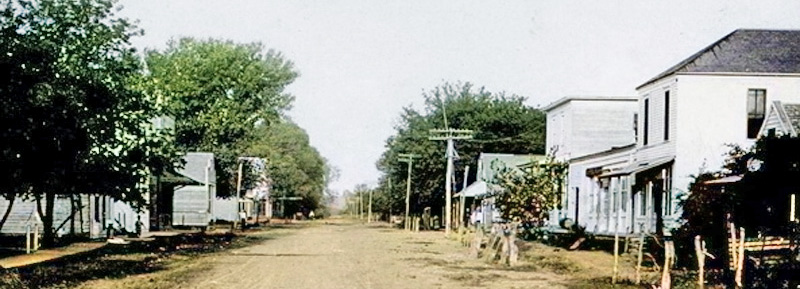
Ionia, Kansas Main Street.
More Extinct Towns:
| Town | Post Office Dates | Additional Information |
| Amity | 1872-1886 | In Highland Township, Amity had one of the first post offices in Jewell County, with James Mitchell as postmaster. |
| Arastella | 1879-1881 | Arastella was in Burr Oak Township with James McCormack, a postmaster. It was near the Mitchell County boundary line, on the Central Branch Union Pacific Railroad, 23 miles from Mankato, and about 13 from Beloit. |
| Arcon | 1873-1877 | |
| Athens | 1871-1901 | Athens was near Limestone Creek, in Athens Township, in the southwestern part of Jewell County. It was 16 miles from Mankato, 11 miles from Cawker City, the nearest bank location, eight miles from Glen Elder, and 11 miles from Jewell City. The three later places were Central Branch Union Pacific Railroad shipping stations. Mail was delivered daily. Morris Gray was the postmaster. |
| Aurora | 1871-1882 | Aurora was established in October 1871 in the southeastern part of Jewell County. It was located on the Central Branch of the Union Pacific Railroad. In 1880, its population consisted of a few families who shipped wheat and corn. At that time, it had stagecoach service to Beloit, the nearest bank, and to Jewell and Mankato. It was 18 miles southeast of Mankato and eight miles north of Beloit. |
| Big Bend | 1871-1875 | The post office site moved to Spring Valley, Nebraska. |
| Bishop | 1873-1892 | Bishop was established in 1869 on White Rock Creek in northeastern Jewell County. In 1880, its principal exports were wheat, barley, and hogs, and it had a stagecoach to Edgar, Nebraska, its nearest shipping point. |
| Branch | 1889-1892 | |
| Branchport | 1871 | The post office was only open for about four months. It moved to Holmwood when it closed. |
| Cerro Gordo | 1873-1888 | In Grant Township, Cerro Gordo was allegedly named by a veteran of the Battle of Cerro Gordo near Veracruz, Mexico, during the Mexican-American War. Postmaster William Bellows opened the Cerro Gordo Post Office on August 19, 1873. It was the first post office in the township. Cerro Gordo was incorporated in January 1879 by C.L. Emery, Joseph Lehman, J.S. Turner, Charles Murphy, and E. Monasmith. At that time, the townsite consisted of 20 acres.
By 1880, the Kansas Gazetteer reported that 600 people lived in the township. At that time, the community was served by the Central Branch Union Pacific Railroad, had a sod church and a school, a wagonmaker, a blacksmith, and a justice of the peace. In 1881, the postmaster, Archie McGowan, started a country store at the post office. The following year, there were petitions for a tri-weekly mail service. Cerro Gordo’s post office closed on January 31, 1888. Ephraim and Mathilda Monasmith, Clarence, and Blanche Emery were the only incorporators who remained in the Cerro Gordo area. All four are buried in the nearby Balch Cemetery. The townsite was located along U.S. 36 Highway in the eastern central part of Jewell County, It was 14 miles from Mankato and nine miles from Scandia, its nearest shipping point. |
| Chauncey | 1882 | The post office was only open for about three months. |
| Dentonia | 1882-1903 | Dentonia, in Odessa Township, was first settled in 1882 with the establishment of a post office. Its post office was closed in 1903. The community’s population peaked in 1910 at 60 residents. At that time, it had a blacksmith’s shop, a doctor’s office, a dance hall, a store, a church, and a school. Ten years later, its population had dropped to 34. The Dentonia United Church of Christ was started in 1936, and the building was constructed in 1938. At some point, its store closed and was torn down in 1959. The town lost its last residents after the school closed in 1964, but the church continued to hold services until 1998 and was destroyed by a fire in 2002. The settlement was 18 miles southwest of Mankato, at the intersection of I Road and 30 Road. |
| Excelsior Colony | None | Early in May 1869, a colony of Scotch mechanics from Brooklyn, New York, located in far western Jewell County. This group of 200 families, composed of farmers and mechanics of various trades, intended to found a town to operate various factories. |
| Glenora | 1874-1878 | |
| Goldie | 1883 | The post office was only open for about four months. |
| Greenville | 1871-1873 | |
| Gregory-Holmwood | 1871-1900 | The post office moved from Branchport to Holmwood in 1871. This village was situated on White Rock Creek in Holmwood Township, in the northern central part of Jewell County. In 1880, it had Baptist and Methodist congregations, a free school, a daily stagecoach from Scandia, two blacksmiths, two constables, a general store, a mill, a justice of the peace, and shipped grain and livestock. At that time, it was a young and flourishing town, but it was unfortunate when the Central Branch Union Pacific Railroad went to Burr Oak, only five miles west. Surrounded by a fertile and well-settled district, its growth began to stagnate after it was bypassed by the railroad. The town’s name changed from Holmwood to Gregory on August 10, 1885. It was eight miles north of Mankato and five miles east of Burr Oak. |
| Harrison | 1877-1901 | This hamlet was located in Harrison Township, on White Rock Creek. In 1880, it had two Methodist Episcopal societies — German and English, a school district, a weekly stagecoach to Holmwood, and a population of 140. It also boasted carpenters, a stonemason, a blacksmith, a photographer, and a wagonmaker. In 1910, its population had dropped to 20, and it received mail from Mankato. It was 12 miles north of Mankato. |
| Ibaton | 1873-1886 | Ibaton was a farming settlement in Esbon Township, in the western central part of Jewell County. It was named for Iba, the daughter of daughters of Thomas Comstock, one of the first settlers above Burr Oak on White Rock Creek. In 1880, it had a population of about 200, a stone Catholic Church building, Methodist and United Brethren congregations, a school, and a grocery store. It was 12 miles from Mankato and 19 miles from Cawker City. |
| Ionia | 1871-1982 | Ionia, Kansas, is a ghost town near the middle forks of Limestone Creek in the southern part of Ionia Township of Jewell County, Kansas. |
| Johnsonville | 1871-1885 | Near the center of Vicksburg Township, Johnsonville had one of the first post offices in Jewell County, with Captain O.F. Johnson as postmaster. The town was named for him. In 1880, it had daily stagecoach service to Scandia and Cawker City. It was located in the southeastern part of Jewell County, 18 miles from Mankato, 12 from Jamestown, and an equal distance from Scottsville. The town shipped grain and livestock from Mankato or Jamestown. |
| Little Oak | 1879-1880 | Little Oak was in the southwestern corner of Jewell County, eight miles north of Cawker City, from which it receives a daily mail after its post office closed. |
| Lovewell-Lovewell Station | 1888-1972 | Lovewell, Kansas, is a ghost town in Sinclair Township of Jewell County. In 1910, it had express and telegraph offices, a post office, and a population of 200. By 1915, Lovewell was being hailed as the fastest-growing town in the county. |
| Marsh Valley | 1872-1875 | |
| Mayview | 1872-1904 | This hamlet of Jewell County was located in Brown’s Creek Township. It was established in 1871 on a stream of that name. In 1880, it had a Methodist Episcopal church society, a school, district, a general store, and a population of 25. Corn, wheat, hogs and cattle were marketed. In 1910, it had a population of 35 and received its daily mail from Jewell. |
| Modoc | 1875-1876 | |
| Montrose-Delta | 1872-1974 |
When this town was established, it was first called Delta. The name changed from Delta to Montrose on January 6, 1888. In 1910, it had banking facilities, a post office, express and telegraph service, a good local trade, and a population of 156. The post office closed on December 6, 1974. It is located seven miles east of Mankato, the county seat, and five miles from Formoso. |
| North Branch | 1878-1959 | North Branch was a Quaker settlement in Walnut Township, in the northwestern part of Jewell County. This old town still boasts several homes, the active Friends Church, a cemetery, and a few other buildings. |
| Oakland | 1870-1878 | |
| Odessa | 1878-1888 | Odessa was located in Ionia Township, in the southwestern part of Jewell County. In 1880, it had a Methodist Episcopal Church, a school district, two stonemasons, a boot and shoemaker, a wagonmaker, a blacksmith, several carpenters, and a stable. Stagecoaches ran daily through the town to Cawker City and Red Cloud, Nebraska. It was 18 miles from Mankato and 17 miles north of Cawker City, the nearest shipping point for its livestock and grain products. |
| Omio | 1877-1889 1890-1895 |
Omio, in Vicksburg and Grant Townships, was located in the eastern part of Jewell County. Except for one old building, the town is gone today. Omio was 16 miles east of Mankato and 14 from Scandia. |
| Otego | 1877-1954 |
Otego is an unincorporated community in Jewell County, Kansas, eight miles west of Mankato, the county seat. A post office was established on November 11, 1887. In 1910, it was on the Chicago, Rock Island & Pacific Railroad, had a money order post office with one rural route, express and telegraph offices, a good local trade, and a population of 175. Its post office closed on March 15, 1954. Sitting amid rich farmland, there Otego still has a railroad, a grain elevator, several silos, and agricultural buildings. The community is served by Rock Hills USD 107 public school district in Mankato. |
| Quaker Point | 1875-1878 | The post office moved to North Branch when it closed. |
| Rapture | 1892-1893 | |
| Rubens | 1871-1900 | Rubens was located on White Rock Creek in Richland Township. One of the oldest settled communities in the county, it was the scene of several Indian outrages, including an attack on the home of John Marling in 1866 when his home was destroyed, and his wife and baby were abused.
In 1880, it had a district school, Presbyterian, Methodist, and Baptist societies, two blacksmiths, a hardware store, a milliner, two general stores, a druggist, a dry goods and grocery store, a constable, and a justice of the peace. It marketed hogs, cattle, and wheat, and mail was delivered daily to R.T. Kinkade, the postmaster. The closest railroad was in Scandia, and the nearest bank was in Jewell Center (Mankato). At that time, the township’s population was about 500. Being a town without a railroad, it declined but did a fair local trade in general merchandise and farm machinery in the early 1900s. The population was 32 in 1910. It was six miles northeast of Mankato, the county seat, from which it received mail after its post office closed. |
| Salem | 1871-1903 | Salem, situated ten miles east of Burr Oak in the fertile White Rock Valley, was an inland town in White Mound Township. In 1910, its population had dropped to 51. Its only remains today is the cemetery. |
| Steuben | 1875-1882 1887-1889 1891-1900 |
Steuben, a hamlet in the northern central part of Jewell County, was located on White Rock Creek in Holmwood Township. In 1880, it had a Baptist Church, a district school, a general store, a blacksmith and wagonmaker, and two livestock dealers; the postmaster, William T. Hunter, received mail daily, and the community had a population of 100. It was eight miles from Scandia, the nearest shipping point, and 16 miles from Mankato, the county seat and nearest bank, where it received daily mail after its post office closed. According to the census of 1910, there were 15 people in Steuben. |
| Upland | 1874-1886 | Upland was a sparsely settled place in Highland Township in the northwestern corner of Jewell County. It was 25 miles from Mankato and 40 miles due north of Cawker City on the Central Branch of the Union Pacific Railroad, from which a daily mail stage passed through. |
| Vicksburg | 1870-1881 | Vicksburg was founded in 1870 on Buffalo Creek in the southeastern part of Jewell County. By 1880, the Central Branch Union Pacific Railroad had just been completed through here, and the community shipped wheat, hogs, and cattle. Daily stagecoaches ran between Jewell City and Scottville. M. Betzner was the postmaster, grocer, and druggist, and the population was 150. The post office moved to Randall when it closed. Vicksburg was 23 miles from Mankato. |
| Westhope | 1873-1879 | After its post office closed, Scottsville was the nearest office. |
| White Mound | 1871-1879 | White Mound, in White Mound Township, was named after a single large outcropping of white rock on the prairie. Thomas Comstock from Iowa, one of the first settlers, took a claim above Burr Oak on White Rock Creek in 1870. He became the first postmaster. The post office was located in the northwest corner of the intersection of U Road and 70 Road. |
©Kathy Alexander/Legends of Kansas, November 2024.
Also See:
Sources:
Blackmar, William; Kansas: A Cyclopedia of State History, Standard Publishing Co., Chicago, IL,1912.
Cutler, William; History of the State of Kansas, A.T. Andreas, Chicago, IL, 1883.
Jewell County Directories 1880, Kansas State Gazetteer and Business Directory, R. L. Polk & Company, Detroit, MI
Jewell County Post Office History
Kansas Positive Press
Kansas Postive Press – 2
Lovewell History
Scarbrough, James A. and Winsor, M.; History of Jewell County, Kansas, Diamond Printing Office, Jewell City, Kansas, 1878.

